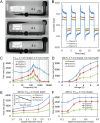Liquid metal enabled pump
- PMID: 24550485
- PMCID: PMC3948272
- DOI: 10.1073/pnas.1319878111
Liquid metal enabled pump
Abstract
Small-scale pumps will be the heartbeat of many future micro/nanoscale platforms. However, the integration of small-scale pumps is presently hampered by limited flow rate with respect to the input power, and their rather complicated fabrication processes. These issues arise as many conventional pumping effects require intricate moving elements. Here, we demonstrate a system that we call the liquid metal enabled pump, for driving a range of liquids without mechanical moving parts, upon the application of modest electric field. This pump incorporates a droplet of liquid metal, which induces liquid flow at high flow rates, yet with exceptionally low power consumption by electrowetting/deelectrowetting at the metal surface. We present theory explaining this pumping mechanism and show that the operation is fundamentally different from other existing pumps. The presented liquid metal enabled pump is both efficient and simple, and thus has the potential to fundamentally advance the field of microfluidics.
Conflict of interest statement
The authors declare no conflict of interest.
Figures



References
-
- Atencia J, Beebe DJ. Controlled microfluidic interfaces. Nature. 2005;437(7059):648–655. - PubMed
-
- Wu T, et al. A photon-driven micromotor can direct nerve fibre growth. Nat Photonics. 2012;6(1):62–67.
-
- García M, et al. Micromotor-based lab-on-chip immunoassays. Nanoscale. 2013;5(4):1325–1331. - PubMed
-
- Lee J, Kim CJ. Surface-tension-driven microactuation based on continuous electrowetting. J Microelectromech Syst. 2000;9(2):171–180.
-
- Wang C-C, Yao Y-D, Liang K-Y, Huang C-C, Chang Y-C. Development of a miniature fan motor. J Appl Phys. 2012;111(7):07E718.
Publication types
MeSH terms
Substances
LinkOut - more resources
Full Text Sources
Other Literature Sources
Medical
Miscellaneous

